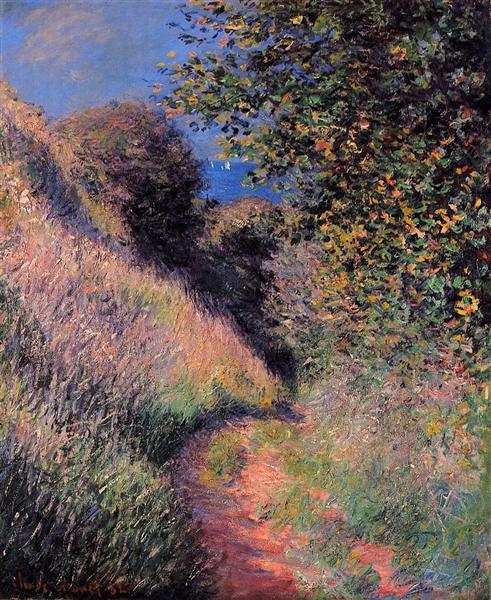Beschrijving
Claude Monet's "Road at Pourville", painted in 1882, is a remarkable depiction of the landscape in which the Impressionist master manages to capture not only the light and colour of the surroundings, but also an atmosphere of serenity and connection with nature. In this painting, which is set on the coast of Normandy, Monet employs his signature style of loose brushstrokes and vibrant colours, allowing for an almost instant perception of the fresh air and changing weather.
The composition is structured around a path that meanders towards the horizons of the painting, guiding the viewer's gaze from the foreground, where green fields dotted with violet and yellow flowers appear, towards the gentle hills that fade into the background. The path, delimited by a vibrant strip of darker grass, becomes a visual axis that invites exploration of the landscape. The choice of perspective, which makes the viewer feel almost part of the scene, is a master technique of Monet, who knew how to break down the barriers between art and the contemplative gaze.
The use of colour in “Road at Pourville” is particularly significant. Monet, faithful to his impressionist approach, uses a palette that oscillates between intense greens, bright yellows and light blues. This chromatic range not only brings luminosity to the work, but also enhances the different textures of the landscape, from the softness of the grass to the roughness of the dirt road. The interplay of these colours creates an almost vibrant effect, capturing the essence of a sunny day in the countryside.
It is fascinating to note that the work, although lacking characters in a traditional sense, suggests human presence through the path itself. This path is not only a physical element, but evokes the idea of exploration and discovery, a space where the viewer could imagine the intervention of people walking, sharing the experience of nature and, through their passage, transforming the landscape that Monet has so meticulously portrayed.
"Road at Pourville" falls within the tradition of French landscape painting, and specifically Monet's compositions that seek to depict the same place at different times of day and in different weather conditions. This work, though relatively lesser known compared to his other works, stands out for its freshness and ability to evoke the simplicity and beauty of everyday life. The decision to capture a fleeting moment, a moment of calm in the flow of nature, is a testament to Monet's approach, whose work is rooted in Impressionism but also opens up to a broader exploration of perception and visual experience.
When looking at "Path at Pourville," it is possible to pause and reflect on Monet's mastery in transforming a simple path into a symbol of connection with the environment. The painting not only offers us a visual portrait, but also invites us to imagine the life that could inhabit these landscapes, where the ephemeral nature of light and color serves as a reminder of the beauty that surrounds us and of our relationship with the natural world. Through his technique, vision, and sensitivity, Monet transports us to a space where nature and human beings converge, remaining engraved in the visual memory of the observer.
KUADROS ©, a famous painting on your wall.
Hand-made oil painting reproductions, with the quality of professional artists and the distinctive seal of KUADROS ©.
Painting reproduction service with satisfaction guarantee. If you are not completely satisfied with the replica of your painting, we will refund 100% of your money.

